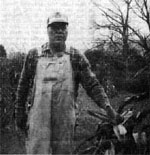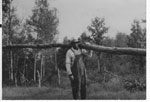Land brought the first settlers to the upper reaches of Dry Fork. The land gave them the opportunity for economic independence and was their guarantee of freedom. Farming the creek bottoms and timbering the mountains sustained families and provided basic needs for the home. The close proximity to the coal fields and the location of the railroad station at Ingleside just over East River Mountain provided outside job accessibiltiy that enabled Dry Fork to thrive, while other communities slowly dwindled. Finally, the isolation of Dry Fork provided one last source of income, moonshine whiskey.
The Dry Fork Community became prosperous during the first half of the twentieth century. M.H. Ferguson was a full time farmer. All the land was cleared from his house down to his son Reuben’s place. Pete Ferguson recalls his ancestors this way.
“I just heard 'em talk, like I say, the old people, they didn't do too much talking. They just come in here and they went to work cleaning up property, and cleaning up the land, and raising their families and kids and stuff and trying to survive.”They did more than just survive. M.H. was Pete’s grandfather and Pete remembers his grandfather’s barn to this day.
“It's torn down now, they tore it down, and he had a barn - aahhh wow, he had a barn. He had a log barn built over there, and that barn would stable. .. . two, four, six, eight mules. He would stable eight mules in that barn, and he had it built. He could put two, four, six - he could put six, he could put six wagons of hay, six wagons, I say, six wagons, on one side of it. And right up on the other side, he could pull up under, and there'd be at least three end-to-end wagons out there. And right over on the north side of it, that's where he stabled a lot of his farm equipment. He could stable farm equipment in all of it.”
Farming was the most direct bounty of the land and the most beloved. It was the full time occupation of the first generation on Dry Fork. It is always recalled with fondness, it was a labor, but a labor of love. Martha Cobb recalls..
“What ever they needed for the farm, like plows and then they had what they call a harrow to drag the ground and tear up the clods and then they come back and lay the rows off and plant it. They had things like corn planters and stuff like that where you could do it walking. It had like two handles on it, stick it in the ground and do like that and the corn would come out and you go to the next one all the way. That was about the only thing you could plant was small seeds with it. Potatoes you would have to drop them in the ground, they made hot beds and growed their own tomatoes and sweet potato plants and stuff like that, peppers or whatever they sold.”
As time passed the economic pressures on the small farmer increased. Mechanization made farming small acreages less and less viable. All over the South and in Appalachia farming became a marginal occupation at best. The Blacks of Dry Fork had a very important advantage in the struggle to survive in the South. They were not share croppers or tenant farmers, they owned their land.
There was much timber in the mountains and sawmills were located at various locations through the years. Pal Saunders operated a small saw mill, as well as a grain mill along Dry Fork. His son, Fred remembers him bringing sawmill and moonshining men from Floyd County to work with him. The saw mill was operated by a steam engine and the grist mill was powered by the dammed waters of Dry Fork. Fred recalls that the grist mill would sometimes operate late into the night. As a small boy he would often be called upon to hold liter knots to provide illumination for the workers.
“And when I was a boy, they would work all night, and I used to go to the pond, to hold the liter knot for the men, and I’d go to sleep there, and that hot tar dripping on my hand! Ha ha ha! That would wake me up
Pal Saunders did well, and he was the first man in the community to own an automobile. He bought it from Dunn Motors in Bland, and it was surely a prized possession. Other residents of the community at various times had small sawmill operations. Pete Ferguson and his brother Mack went in together and ran a small operation. A railroad was built up Wolf Creek from Narrows to Rocky Gap. Its purpose was to bring back tanning bark for the Snowflake Tannery in Narrows. Lee Tynes remembers his dad, Ferguson Tynes, talking about the tanning bark trade.
“Cause I heered my—my Daddy said that down here at—where they's the Stower's store--Mr. Honaker had a store there, see, he was in debt for a lot of feed—a lot of stuff down there and they hauled 'em and rode a wagon and hauled tannin' bark and paid it off—and they was children. Nothin' but boys, you know. They was pretty good sized boys.”
Marvin Tynes remembers his grandfather, father, and uncles working in the lumber trade.
“The truck, they bind it with a chain and a pole. It use to ship out of Rocky Gap, down here, by train. My granddaddy use to ship lumber out of Rocky Gap. When grandpa Jack died, Uncle Jim and Daddy hauled it on the road with a wagon from here to Rocky Gap, hauled railroad ties, ship building stuff. Grandpa Pal got a letter from England saying he had the best stuff that had ever been sent over there. That was grandpa Pal, my mother’s father.”
Camps were built for some of the larger mills and some workers were brought in from the outside. Charlie Taylor was a white man who owned a great deal of land beyond the black settlement up on Pond Mountain. He engaged in many timbering operations along with others. Camps were made for outside workers to stay. The blacks helped to build them and also worked in the timbering operations.
Would you like to return to the top of the page?
copyright©bland county history archives all rights reserved 2000

